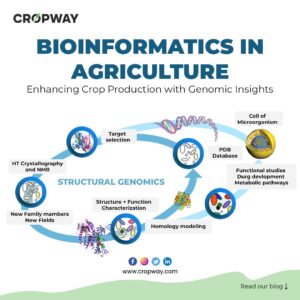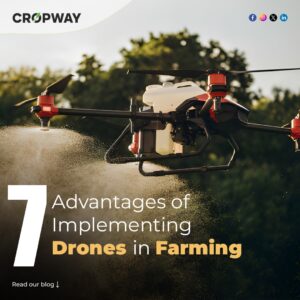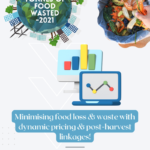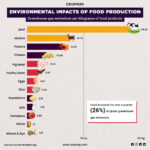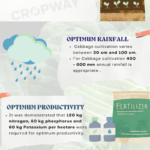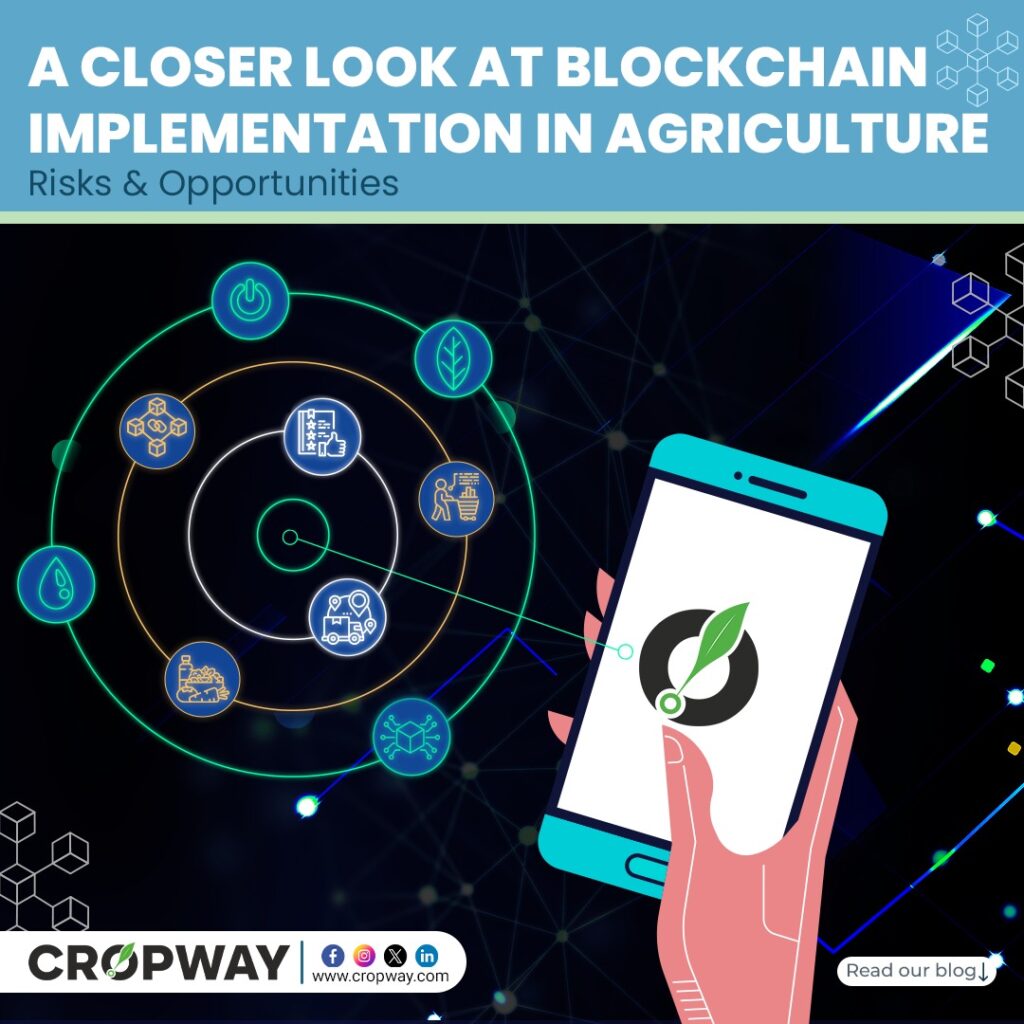
Introduction:
As the role of information & communication technologies increases in various sectors of agriculture, it enhances new opportunities to leverage those developments in capacity development, disaster management, market access driven by e-commerce, finance, and logistics. Given the looming food crises, one of the most impactful deployments of technology is blockchain. In simple terms, blockchain is a distributed ledger that contains a chain of auditable data called blocks. Once a block records a transaction, the data it holds can’t be changed without impacting the rest of the transactions (refer. Figure 1).
Its immutable and distributed nature makes it an excellent enabler of traceability in the agriculture supply chain. In recent years, food provenance, quality, and safety have emerged as significant concerns for consumers, particularly in light of food epidemic incidents. For instance, considering recent food safety concerns such as contamination outbreaks, fraudulent labeling, E. coli infected cucumber in Germany, or the mad cow disease outbreak in the United Kingdom in 1996, a more transparent information system could help intensify owning safety scandals of recent years.
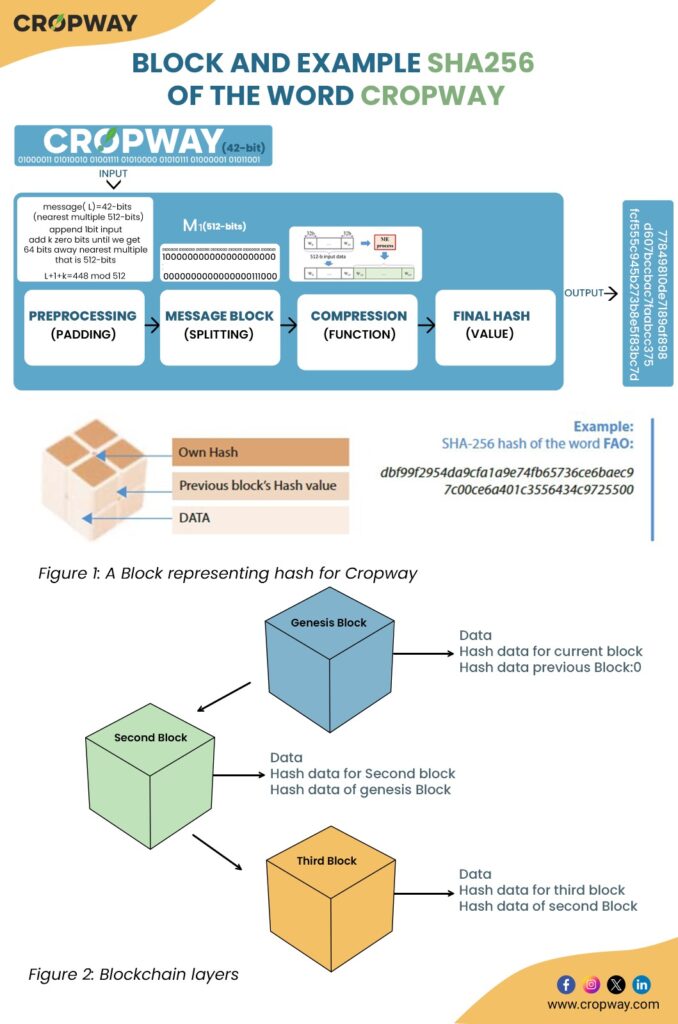
While blockchain is currently undergoing pilot implementations in diverse sectors like finance, energy, and government, it faces certain challenges. According to a PWC study on blockchain initiatives, respondents who reported little or no involvement with blockchain cited cost (31%), uncertainty over where to start (24%), and governance issues (14%) as reasons for the lack of progress. Despite its potential, trust emerged as a significant obstacle to blockchain adoption, with 45% of respondents identifying it as a blocker. Additionally, 48% of respondents expressed concerns about regulatory uncertainty.
Opportunities in Agricultural Blockchain Implementation
The food supply chain is an intricate and extensive process involving numerous intermediaries and a multitude of transactions from the farm to the fork. In this intricate web, the flow of information is considered valuable. However, this information flow is dual in nature: the physical products move from producers to manufacturers, distributors, and finally, to the consumer, while financial transactions occur in the opposite direction—moving from the consumer back to the source of produce.
This dual flow increases the potential for misinformation and fraud, presenting challenges within the system (refer to Figure 3). Even with the advent of new scientific methods enabling the detection of food fraud, the issue persists and continues to affect the global food industry. The estimated percentage of product fraud on a global scale ranges from 5 to 7% of world trade, leading to an annual cost that can reach as high as $40 billion.
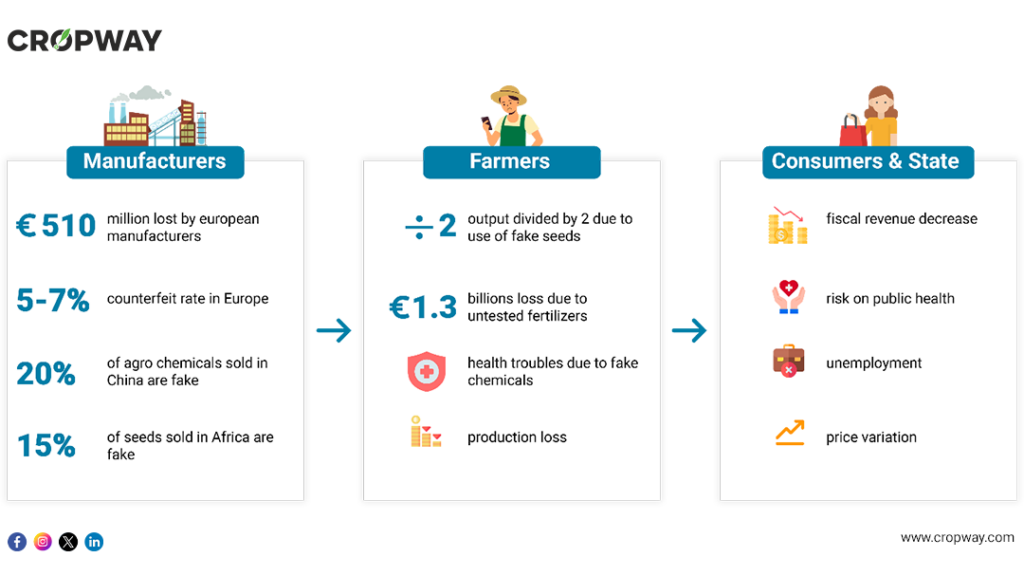
As more consumers demand information about the food they consume, and suppliers grapple with the friction between demand and supply necessities, the importance of establishing a trustworthy system becomes evident. For example, according to the Food and Agriculture Organization (FAO), global trade in counterfeit goods suffers a staggering $500 billion annually. The absence of verifiable and data-rich assets allows counterfeit goods to infiltrate supply chains in large quantities. The tangible impact is evident in the real cost borne by end consumers, with food security becoming an escalating concern. Numerous high-profile food contamination cases have had widespread global repercussions, highlighting the critical need for robust supply chain solutions.
Blockchain finds diverse applications in the agricultural sector. Research by Markets and Markets reveals that with implemented blockchain, the agriculture supply chain estimated market size $133 million in market value in 2020 and is predicted to generate $948 million in value by 2025.The same report also states the CAGR is growing at 48.1% during the projected period.
Some relevant examples of blockchain in agriculture:
- From ensuring incorruptible land registrations through blockchain-based implementations.
- Tracking and deterring illegal, unreported, and unregulated fishing in the fisheries sector.
- Generates smarter market data for better decision-making with data science in agriculture.
- It providesprovenanceof the information related to plants, including details about seed quality, crop growth, and the entire journey of the plant post-farm, leading to a reduction in waste.
- Reducesfraudulent financial transactions and promotessafe inclusive trade.
- Additionally, facilitates informed consumer purchasing decisions and sets the stage for future transactions with the elimination of fraud, ensuring a seamless and trustworthy process.
Case Studies: Successful Blockchain Implementation in Agriculture
Blockchain can oversee all supply chain activities within a decentralized, independent, shared network, grounded in blockchain integrity. Consequently, it removes the necessity of collaborating with external third-party organizations or systems to facilitate communication. Distributed ledger technology(DLTs) leverages defined principles such as peer-to-peer(P2P) network, decentralization, consensus algorithms, and cryptographic signature called a hash. Let’s explore real-life examples of how cropway’s blockchain services can make a positive impact on agriculture supply chains.
- Seamless Input Supplier to Farmer Transactions via Cropway:
- The supply chain begins with agri input suppliers recording the sale of their product in the distributed digital ledger to farmers through the Cropway platform.
- Information includes product price and quality etc.
- Data Cleaning and Metadata Inclusion:
- Before data is stored on the distributed storage platform, there are several mechanisms in place to manage the accuracy, size, and reliability of the data.
- Metadata, including timestamp types, demographics, and data structure details, are included for effective data organization. A famous protocol that is used called “sharding”, where only a manageable portion of the blockchain database is used to reduce storage requirement for each node.
- Another method is off-chain storage i.e. bulky data such as files, contracts, and papers are stored onto a separate database or cloud. Some implementation examples: IPFS (InterPlanetary File System), BigChainDB, File.io, Amazon S3/Azure Blob Storage/Google Storage etc.
- Processing & Packaging:
- The farmer sells the harvested crop to the processor. The processor, in turn, transforms the raw crops into final products for the ultimate customer.
- During this transformation, the processor records essential batch information, storage conditions, quantity, and other relevant details in IPFS (InterPlanetary File System). The resulting data hash is then saved in the blockchain to ensure data integrity.
- This packed crop is sent to the packer for packaging.
- At the packing stage, product labeling, and additional measures such as product RFID are securely stored in the blockchain.
- A data label is created and affixed to the product package for traceability and transparency.
- Distribution, customs & retail:
- Following the completion of packaging, the product is prepared for distribution. That is initiated based on the scheduled delivery time, often within a specified timeframe, allowing for potential storage if required.
- Research suggests that integrating additional sensors and automation into the blockchain can inspire total quality management to incorporate devices’ certification and calibration, further elevating product quality standards.
- Retailers procure products from distributors and subsequently sell them to consumers in smaller quantities.
- Basic retailer information, including sale time, quantity sold, and hash value, is securely stored in IPFS.
- Consumer:
- Consumers, upon purchasing agricultural food, can access comprehensive supply chain information by scanning the barcode, RFID, or QR code on the product package.
- This user-friendly approach facilitates easy tracking, enhances transparency, and promotes a deeper understanding of the food supply chain for consumers.
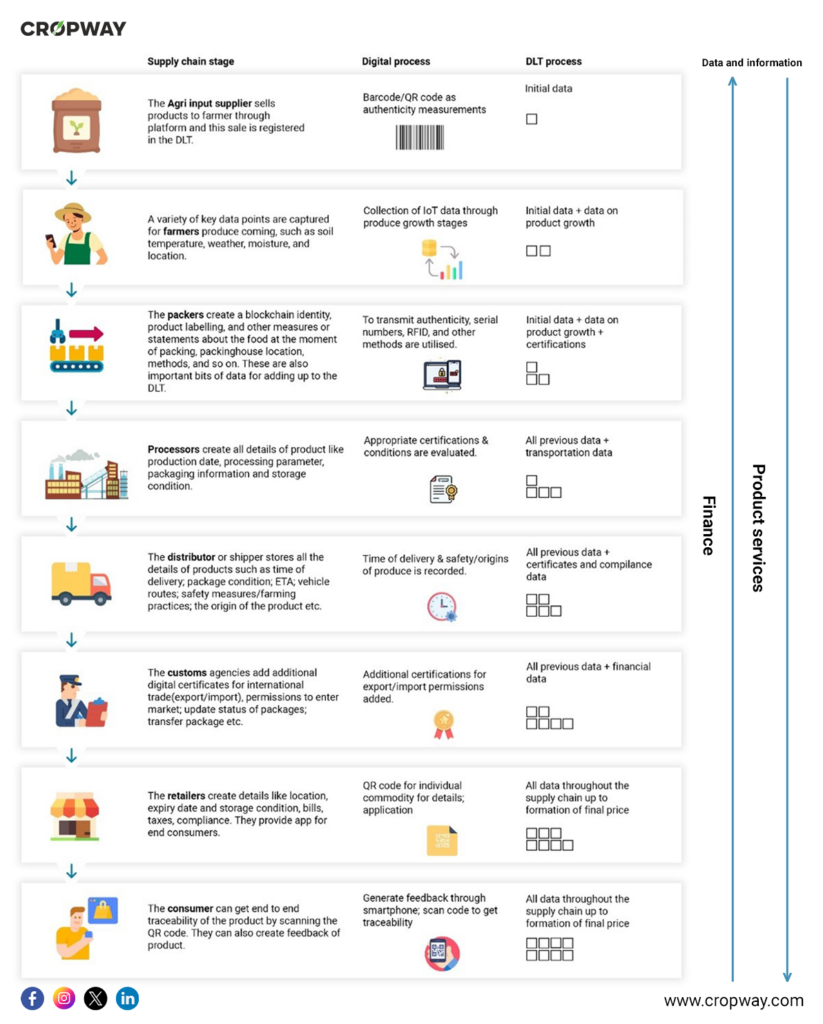
Challenges and Considerations for Future Integration
While distributed systems offer substantial benefits, it’s crucial to acknowledge certain drawbacks. Unlike other industries, agricultural production is heavily dependent on factors such as weather conditions, diseases, and the use of pesticides, which are challenging to monitor and manage. The lack of comprehensive traceability in the agricultural supply chain results in sluggish economic processes and often complicates transactions.
Additionally, the risk of counterfeits is present at various stages in the supply chain, posing potential harm to all involved parties, including businesses, government entities, and customers. Limitations in real-time processing and computation-intensive queries can pose challenges, particularly in handling specific use cases. Additionally, not all information is suitable for sharing via blockchain, as certain data may not be relevant to other network participants and could unnecessarily burden the network. Compliance with existing regulations, such as GDPR, further restricts the extent to which personal information can be shared via blockchain. Some challenges or risks involved:
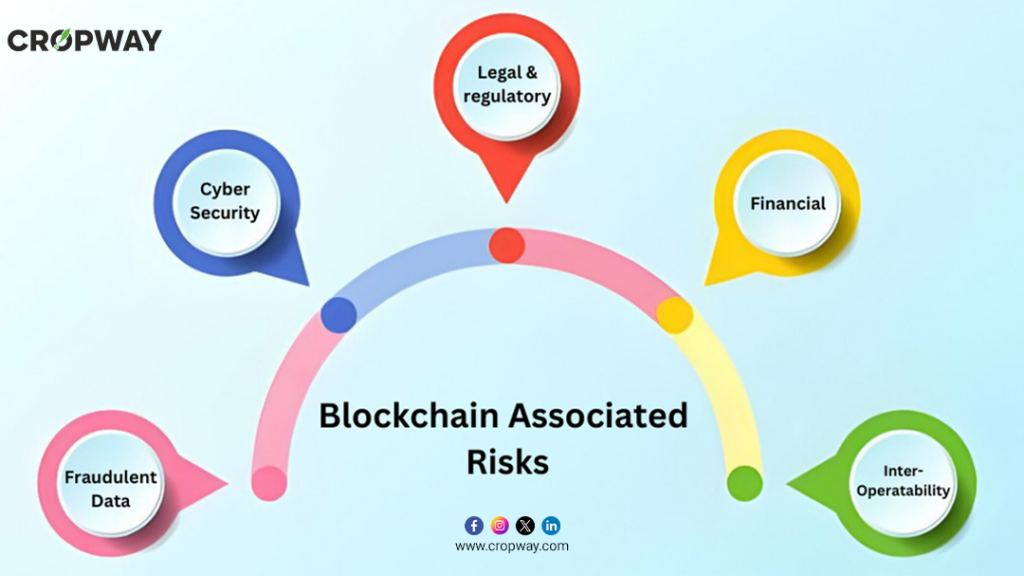
- Fraudulent data:One of the challenges lies in the accuracy and reliability of the data provided by the data provider. Within a particular supply chain, there may be one or more data providers whose information cannot be fully trusted. To ensure the trustworthiness of this data from the point of creation several steps can be implemented – setting up oracles, limiting privileges to vetted actors, establishing anincentivized reputation system, and automation.
- Financial risks:Another key challenge is the cost of collecting data on the leger, especially to facilitate peer-to-peer transactions by maintaining speed and efficiency. In consensus algorithms like proof-of-work (PoW), There is also a substantial investment due to the requirement of high computing resources as each independent node repeats tasks on every other node. To address these challenges, potential solutions involve the utilization of advanced mining hardware and the exploration of alternative consensus mechanisms such as proof-of-stake. Another closely connected issue is the expense associated with storing data, primarily due to redundancy. As blockchain expands and gains wider acceptance, the increased volume of data could potentially lead to system slowdowns.
- Interoperability: With the emergence of numerous blockchain networks, the need for smooth interaction to exchange data and assets between these networks & existing systems gains significance. Individual blockchain networks are siloed, functioning independently, and all of these networks have their different characteristics such as specific protocols and standards, hashing algorithms, or consensus models.
- Legal and regulatory risks:The different nodes can be placed all across the world,therefore it creates complex issues related to legal jurisdictions, especially concerning the platform’s activities, participants, and their contractual relationships. Hence, creating a need for a technology-neutral regulatory regime that takes into consideration different jurisdictional boundaries.
- Cybersecurity: The major security issues encompass a range of threats, including smart contract vulnerabilities, phishing, network attacks, Sybil attacks, and unauthorized access. To ensure and address these multifaceted challenges, organizations should conduct regular security audits, distribute power across the network to prevent single entities from controlling, and implement robust network security measures, such as firewalls and intrusion detection systems. Additionally, regular security tests must be performed on the appropriate consensus algorithms to prevent Sybil attacks and detect anomalies in the network to ensure secure access management.
Conclusion
Blockchain technologies hold the promise of fostering environmentally sustainable agriculture supply chains, streamlining trade processes, and creating a more inclusive trading ecosystem. Acting as a potent catalyst for economic growth, blockchain has the potential to revolutionize financial services, offering new market avenues for micro, small, and medium-sized enterprises (MSMEs). By enabling the substitution of existing methods for exchanging financial information and handling customer records, blockchain introduces transformative possibilities.
However, realizing the full potential of blockchain in financial services requires overcoming several challenges. Businesses must proactively prepare to adapt and transform their services to leverage this technology effectively. This proactive approach is crucial for ushering in substantial changes in the financial landscape through blockchain implementation.
Cropway offers specialized blockchain development services tailored for the agriculture sector, contributing to the enhancement of the global food chain through improved traceability and trust. Our streamlined and efficient information management methods provide easy documentation, reducing reliance on paper-based systems. This not only optimizes operational processes but also bolsters risk prevention and management capabilities. Additionally, our services empower the promotion of product traceability from the farm to the table. By leveraging blockchain technology, Cropway facilitates a more transparent, secure, and efficient agricultural ecosystem, ensuring greater confidence in the integrity of the food supply chain. To know more visit: Blockchain


